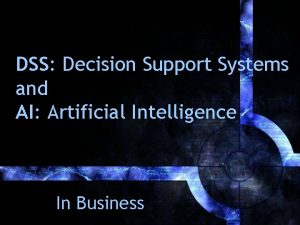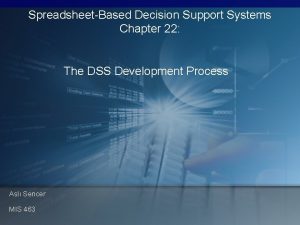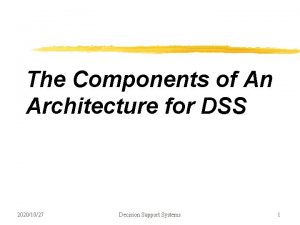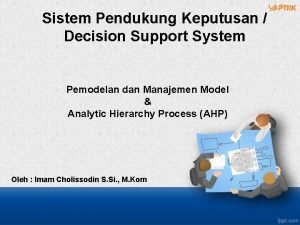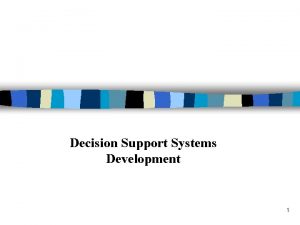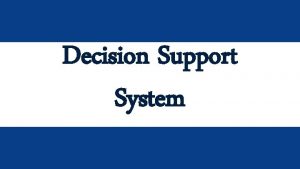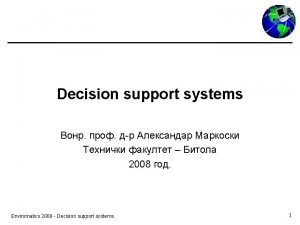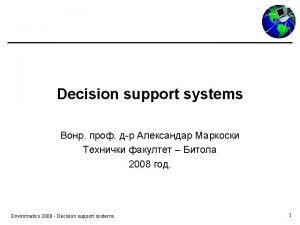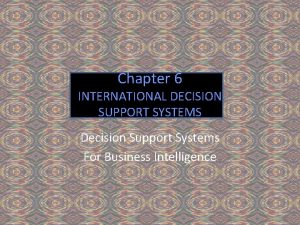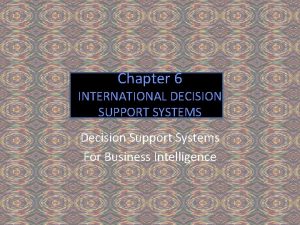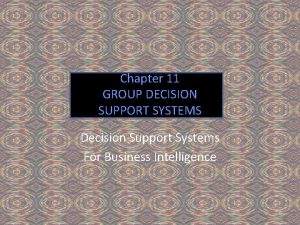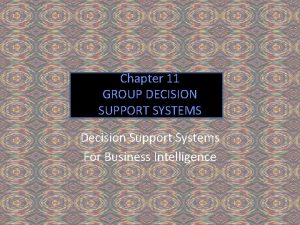Decision Support Systems GIS are system which support












- Slides: 12

Decision Support Systems GIS are system which support humans when taking decisions in scenarioswhere geographic data is crucial

Introduction l l Decision makers are faced with stressful environments – highly competitive, fast-paced, near real-time, overloaded with information, distributed data. The combination of the Internet and artificial intelligence techniques, supports decision making under these risky and uncertain conditions. These aids have the potential to improve decision making by suggesting solutions that are better than those made by the human alone. They are increasingly available in diverse fields from medical diagnosis to traffic control to engineering applications.

Decision Support System l A Decision Support System (DSS) is an interactive computer-based system or subsystem intended to help decision makers use communications technologies, data, documents, knowledge and/or models to identify and solve problems, complete decision process tasks, and make decisions. l Decision Support System is a general term for any computer application that enhances a person or group’s ability to make decisions.

Principal parts of a DSS A DSS is made up of l l a model (or models), a source of data, and a user interface. It is highly interactive Allows user to explore various scenarios which results from different hypotheses l l l Which areas will be covered by a tsunami -> different intensities Which sectors will be polluted -> different wind patterns Which areas will have wireless connectivity -> different antenna arrangement What will be the profit -> different exchange rates

Decision Making process Generar opciones

Types of Problems l Structured: situations where the procedures to follow when a decision is needed can be specified in advance l l Unstructured: decision situations where it is not possible to specify in advance most of the decision procedures to follow l l l Repetitive Standard solution methods exist Complete automation may be feasible One-time No standard solutions Rely on judgment Automation is usually infeasible Semi-structured: decision procedures that can be pre specified, but not enough to lead to a definite recommended decision l Some elements and/or phases of decision making process have repetitive elements DSS most useful for repetitive aspects of semi-structured problems

DSS in Summary A MANAGEMENT LEVEL COMPUTER SYSTEM Which: l l COMBINES DATA, MODELS, USER - FRIENDLY SOFTWARE FOR SEMISTRUCTURED & UNSTRUCTURED DECISION MAKING. l It utilizes data, provides an easy-to-use interface, and allows for the decision maker's own insights.

Why DSS? l Increasing complexity of decisions l l l Increasing availability of computerized support l l Technology Information: l “Data, data everywhere, and not the time to think!” Number and complexity of options Pace of change Inexpensive high-powered computing Better software More efficient software development process Increasing usability of computers

Perceived benefits l l l decision quality improved communication cost reduction increased productivity time savings improved customer and employee satisfaction

Geographic Information Systems l GIS l l l DSS that uses geographic databases to construct and display maps and other graphics displays That support decisions affecting the geographic distribution of people and other resources Often used with Global Position Systems (GPS) devices

Using DSS l What-if Analysis l l End user makes changes to variables, or relationships among variables, and observes the resulting changes in the values of other variables Sensitivity Analysis l Value of only one variable is changed repeatedly and the resulting changes in other variables are observed

Note on DSS l l Decision support systems quite literally refer to applications that are designed to support, not replace, decision making. Unfortunately, this is too often forgotten by decision support system users, or these users simply equate the notion of intelligent support of human decision making with automated decision making.
 Mikael ferm
Mikael ferm Decision support systems and intelligent systems
Decision support systems and intelligent systems Objectives of decision making
Objectives of decision making Financial management process
Financial management process Expert system in dss
Expert system in dss An expert system is
An expert system is Decision categories
Decision categories Decision support and business intelligence systems
Decision support and business intelligence systems Developing spreadsheet-based decision support systems
Developing spreadsheet-based decision support systems Decision support system in business intelligence
Decision support system in business intelligence Types of information system
Types of information system Dss architecture components
Dss architecture components Contoh decision support system adalah
Contoh decision support system adalah





